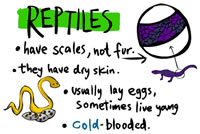Difference between Lizard and Reptile
Key difference: Lizards are a part of the Squamata subgroup of the Reptile family.

Reptiles are members of the Class: Reptilia under the Phylum: Chordata of the Kingdom: Animalia. Modern reptiles are vastly distributed over every continent, except Antarctica. The Class: Reptilia is further distributed into sub-groups:
- Testudines (turtles, terrapins and tortoises),
- Sphenodontia (tuataras from New Zealand),
- Squamata (lizards, snakes, and worm lizards), and
- Crocodilia (crocodiles, gavials, caimans, and alligators).
Lizards are a part of the Order: Squamata of the Class: Reptilia. Hence, lizards are a type of reptiles. They actually make up the biggest order in the reptilian class. There are approximately 5,600 different species of lizards. Like all reptiles, lizards are available on every continent, except Antarctica.
All reptiles either have our limbs or are descended from four-limbed ancestors, for example, snakes. Reptiles live mainly on the ground, while some may also reside in trees. Most reptiles reproduce by laying eggs, however some may retain the eggs until hatching and a few give birth to live young, as similar to mammals.
All reptiles are cold blooded, which means that they have trouble keeping their body temperature constant and often rely on external sources of heat, such as sun basking. The skin of reptiles is rather thin and is protected by scales or scutes. These at times have a bony base, which forms armor.
Most modern reptiles are carnivorous and survive mostly on insects, small to medium mammals and other reptiles. Some reptiles have evolved to survive wholly or partly on plants, including, several types of agamas and iguanas. Currently, turtles are the only predominantly herbivorous reptile group.
Reptiles vary immensely in their sizes and weight. They range from a tiny gecko, which can grow up to 17 mm (0.7 in) to the saltwater crocodile, which can grow up to 6 m (19.7 ft) in length and weigh over 1,000 kg (2,200 lb).
 Most lizards, like all reptiles, are four-limbed, cold blooded and carnivorous. In addition to the feet, they also have external ears, a feature not shared by all reptiles. Lizards also have a unique feature, called autotomy, which allows them to detach their tails to escape from predators. Vision, including color vision, is particularly well developed in most lizards. This is because many lizards communicate with body language or bright colors on their bodies.
Most lizards, like all reptiles, are four-limbed, cold blooded and carnivorous. In addition to the feet, they also have external ears, a feature not shared by all reptiles. Lizards also have a unique feature, called autotomy, which allows them to detach their tails to escape from predators. Vision, including color vision, is particularly well developed in most lizards. This is because many lizards communicate with body language or bright colors on their bodies.
Lizards can range from a few centimeters for chameleons and geckos to nearly 3 m (9.8 ft) in the case of, the Komodo dragon. The Komodo dragon is the largest living varanid lizard today. Other than the Komodo dragon, some of the most commonly known lizards are gecko, chameleon, iguanas, horned lizards, etc. There are also the legless lizards, which look like snakes and are legless, but share a common ancestry with lizards.
Image Courtesy: caitand.weebly.com, balladeer.wordpress.com









Comments
E
Mon, 06/26/2017 - 03:48
thank you for share!
manolo blahnik ...
Thu, 10/09/2014 - 04:44
Add new comment